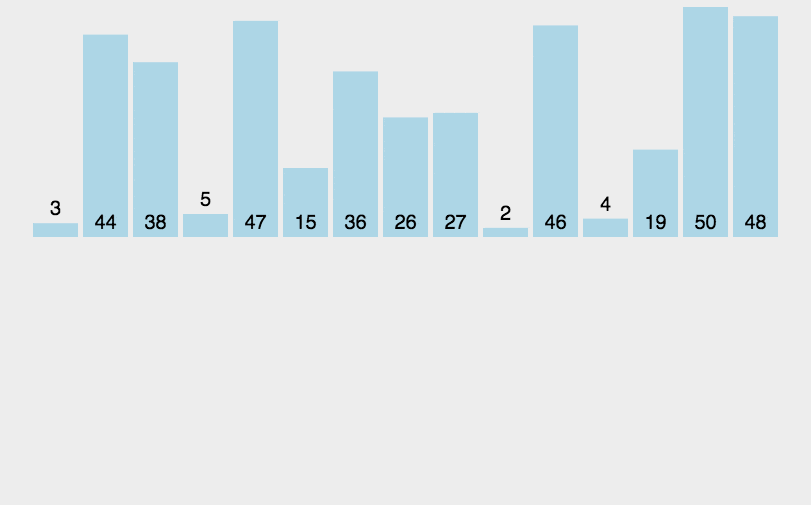排序算法是最基本的算法,本文使用语言为C/C++
详细了解参考以下链接:
十大排序算法
个人认为应该牢记的是归并排序,快速排序,基本的冒泡排序以及sort()函数的使用方法,这些是在比赛和做题时经常遇到的。
各排序算法分析

归并排序
是稳定的排序算法,适用于大规模的基本有序的数据
原理
不断地划分区间,一分二,二分四,直到最后一个小数组只有一个元素,然后开始逐层向上合并,合并时要按想要的顺序(从小到大,或是从大到小)进行选择然后合并,因此要用到递归
原理动图如下:

算法采用C++实现:
1
2
3
4
5
6
7
8
9
10
11
12
13
14
15
16
17
18
19
20
21
22
23
24
25
26
27
28
29
30
31
32
33
34
35
36
37
38
39
40
41
42
43
44
45
46
47
48
49
50
51
52
53
54
55
56
57
| #include<iostream>
using namespace std;
void Merge(int a[],int L,int mid,int R)
{
int len=R-L+1;
int *t=new int [len+1];
int i=L,j=mid+1,k=1;
while(i<=mid&&j<=R)
{
t[k++]=a[i]<a[j]?a[i++]:a[j++];
}
while(i<=mid)
{
t[k++]=a[i++];
}
while(j<=R)
{
t[k++]=a[j++];
}
for(int m=L;m<=R;m++)
{
a[m]=t[m-L+1];
}
delete [] t;
}
void MergeSort(int a[],int L,int R)
{
if(L>=R)
return;
else
{
int mid=(L+R+0.5)/2;
MergeSort(a,L,mid);
MergeSort(a,mid+1,R);
Merge(a,L,mid,R);
}
}
int main()
{
int n;
cout<<"input num of items:";
cin>>n;
int *a=new int[n+1];
for(int i=1;i<=n;i++)
cin>>a[i];
MergeSort(a,1,n);
for(int i=1;i<=n;i++)
cout<<a[i]<<" ";
cout<<endl;
delete [] a;
}
|
快速排序
对完全无序的数据执行结果最优
原理
在一组数据中选择一个基准数,一个左标记,一个右标记,将所有比这个数小的数放在左边,比这个数大的数放在其右侧,不断重复此过程,直至左标记与右标记重合,最后让基准数归位。
原理的动图如下:

用C++实现:
1
2
3
4
5
6
7
8
9
10
11
12
13
14
15
16
17
18
19
20
21
22
23
24
25
26
27
28
29
30
31
32
33
34
35
36
37
38
39
40
41
42
43
44
45
| #include<iostream>
using namespace std;
void swap(int *x,int *y)
{
int temp=*x;
*x=*y;
*y=temp;
}
int sort(int a[],int L,int R)
{
int base=a[L];
while(L<R)
{
while(R>L&&a[R]>base)
R--;
while(L<R&&a[L]<base)
L++;
swap(a[R],a[L]);
}
a[L]=base;
return L;
}
void QuickSort(int a[],int L,int R)
{
if(L>=R)
return;
int mid=sort(a,L,R);
QuickSort(a,L,mid-1);
QuickSort(a,mid+1,R);
}
int main()
{
int N;
cin>>N;
int *a=new int[N+1];
for(int i=1;i<=N;i++)
cin>>a[i];
QuickSort(a,1,N);
for(int i=1;i<=N;i++)
cout<<a[i]<<" ";
cout<<endl;
return 0;
delete [] a;
}
|
sort的基础用法
包含在头文件
中
有三个参数
- 第一个是要排序的数组的起始地址。
- 第二个是结束的地址(最后一位要排序的地址的下一地址)
- 第三个参数是排序的方法,可以是从大到小也可是从小到大,还可以不写第三个参数,此时默认的排序方法是从小到大排序。
第一种用法:直接比较
第二种:传入一个返回值为布尔类型的比较函数,用来进行比较
冒泡排序
原理:前后两个元素进行比较
原理动图:

采用C++实现情况如下:
1
2
3
4
5
6
7
8
9
10
11
12
13
14
15
16
17
18
19
20
21
22
23
24
25
26
27
28
29
30
31
| #include <iostream>
using namespace std;
void swap(int *x, int *y)
{
int t = *x;
*x = *y;
*y = t;
}
int main()
{
int n;
cin >> n;
int *a = new int[n + 1];
for (int i = 1; i <= n; i++)
cin >> a[i];
for (int i = 1; i < n; i++)
{
for (int j = 1; j <= n - i; j++)
{
if (a[j] > a[j + 1])
swap(a[j], a[j+1]);
}
}
for (int i = 1; i <= n; i++)
cout << a[i] << " ";
cout << endl;
delete[] a;
return 0;
}
|



